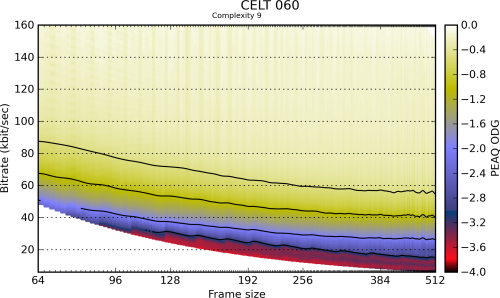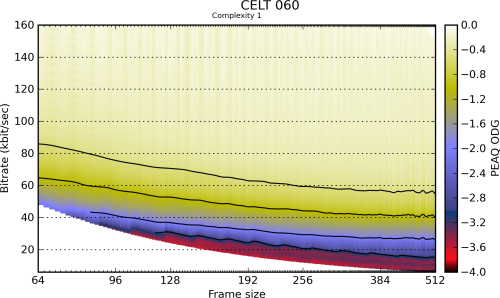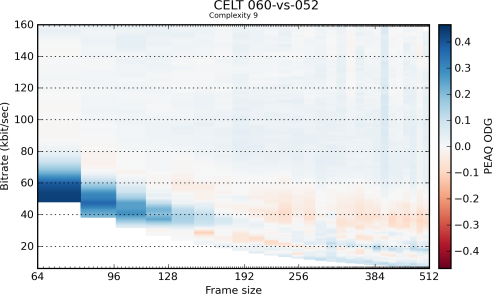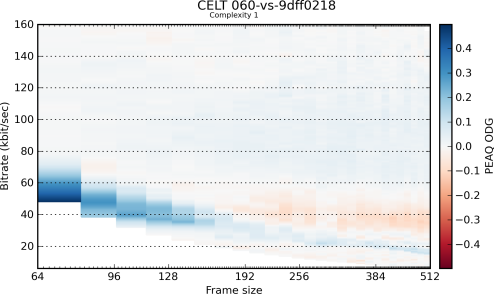 |
| Equal-quality contours are drawn at -0.5, -1, -2, and -3. |
The automated testing routine for CELT involves running roughly 12 months of audio through the CELT encoder and decoder across a wide variety of modes and configurations. All user accessible modes receive at least some level of coverage. 48kHz mono receives automated quality testing of all frame sizes and most reasonable bit-rates. Common configurations receive extensive fuzz testing under valgrind. ARM (OpenMoko), PPC (Fedora 11), x86_64 (Fedora 10, 11), and x86 (Fedora 11) are used in testing.
This level of extensive testing is made possible by the large multiple of real-time that CELT operates at on modern computing hardware.
Keep in mind that as of 0.6.0 CELT is still a work in progress. Neither the API/ABI, nor the bit-stream are stable. Also, while we do not expect it to set your house on fire, we cannot guarantee that it won't. Spontaneous combustion is specifically not covered by these tests.
| Value | Meaning |
|---|---|
| 0 | Imperceptible |
| -1 | Perceptible but not annoying |
| -2 | Slightly annoying |
| -3 | Annoying |
| -4 | Very annoying |
The quality of CELT 0.6.0 at 48 kHz mono was assessed for 51,848 combinations of bitrate, frame size, and complexity using PQEvalAudio, an implementation of PEAQ. The PEAQ objective difference grade does not always accurately reflect human opinion but its automated nature permits testing large numbers of configurations. These quality tests would require over 52 days of continuous listening if conducted with a single human reviewer.
This illustration demonstrates the quality/bitrate/delay trade-offs available in CELT in full (default) complexity mode.
 |
| Equal-quality contours are drawn at -0.5, -1, -2, and -3. |
This illustration demonstrates the quality/bitrate/delay trade-offs available in CELT in low complexity mode.
 |
| Equal-quality contours are drawn at -0.5, -1, -2, and -3. |
PQEvalAudio is run periodically during CELT development to help spot unexpected changes which may be perceptually relevant. Sometimes new functionality will introduce quality impacting bugs which only impact some configurations.
For 0.6.0 this comparative testing appears to show a reduction in performance around 40kbit/sec at typical frame sizes, but this is actually a case of PQEvalAudio disagreeing with actual human listening tests: Towards the end of the 0.6.0 development cycle the codec was retuned based on real listening tests and this tuning is responsible for the decline in the PQEvalAudio score even though the improvement provided by the tuning is obvious to any listener. For comparison graphs are provided comparing 0.6.0 with 9dff0218, a recent version the source code repository immediately prior to these tuning changes.
Several other quality improvements during the 0.6.0 development cycle were partially offset by the introduction of independently coded frames. Now the CELT encoder will automatically encode some frames independently of the prior frames. This makes the stream somewhat more robust to packet loss. Applications can also request the CELT encoder to produce only independent frames, which gives the greatest robustness to packet loss but it requires a somewhat higher bitrate to achieve the same quality.
For each test point the 0.5.2 PQEvalAudio score was subtracted from the CELT 0.6.0 score.
 |
| Positive (blue) values in the chart indicate improvement according to PQEvalAudio, while negative (red) values indicate quality loss. |
For each test point the revision 9dff0218 PQEvalAudio score was subtracted from the CELT 0.6.0 score.
 |
| Positive (blue) values in the chart indicate improvement according to PQEvalAudio, while negative (red) values indicate quality loss. |
For each test point the 0.5.2 PQEvalAudio score was subtracted from the CELT 0.6.0 score.
 |
| Positive (blue) values in the chart indicate improvement according to PQEvalAudio, while negative (red) values indicate quality loss. |
For each test point the revision 9dff0218 PQEvalAudio score was subtracted from the CELT 0.6.0 score.
 |
| Positive (blue) values in the chart indicate improvement according to PQEvalAudio, while negative (red) values indicate quality loss. |
CELT includes a number of unit tests that exercises internal components of CELT.
0.6.0 introduces a new test 'tandem-test' which loops the decoder output back into the encoder
and tests the whole encoder/decoder system at many rates and frame sizes.
| Test | x86_64 | x86 | ARM | PPC |
|---|---|---|---|---|
| cwrs32-test | Pass | Pass | Pass | Pass |
| dft-test | Pass | Pass | Pass | Pass |
| ectest | Pass | Pass | Pass | Pass |
| laplace-test | Pass | Pass | Pass | Pass |
| mathops-test | Pass | Pass | Pass | Pass |
| mdct-test | Pass | Pass | Pass | Pass |
| real-fft-test | Pass | Pass | Pass | Pass |
| tandem-test | Pass | Pass | Pass | Pass |
| type-test | Pass | Pass | Pass | Pass |